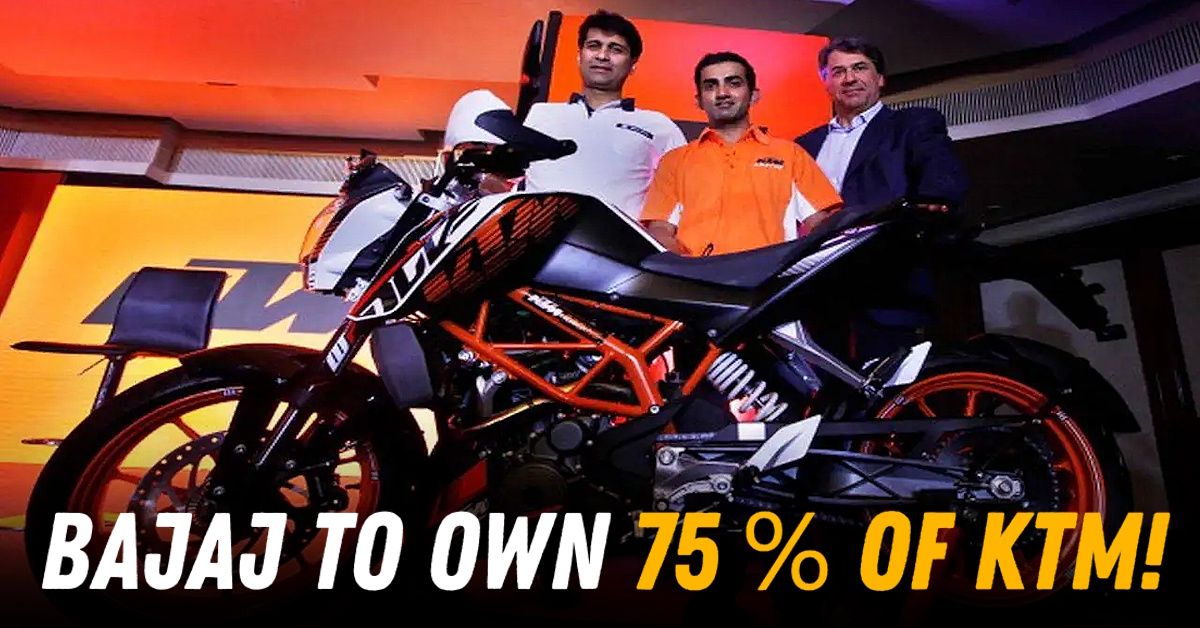Bajaj's KTM Take Over! 75 % Of KTM Will Now Be Owned By Bajaj!


What began as a financial partnership is now moving towards full control. Bajaj Auto has announced its intention to acquire Pierer Mobility AG, the parent company of KTM, Husqvarna and GasGas. The announcement follows months of behind-the-scenes developments, most notably Bajaj’s critical role in rescuing the Austrian two-wheeler group from insolvency. This is not a sudden shift but the culmination of a growing dependency that began years ago and accelerated rapidly in the past 12 months.
Bajaj now holds 37.5 % of KTM through Bajaj Pierer AG, the company that owns KTM, Husqvarna and GasGas motorcycle brands. The latest capital infusion of 800 million euros will give Bajaj the option of buying another 50 % of Bajaj Pierer AG, taking Bajaj's stake in KTM to 75 %. Bajaj has one full year to complete this deal by buying Stefan Pierer's stake in Bajaj Pierer AG for 50.7 million euros, in the process exercising its options anytime before 31st May 2026 This will making Bajaj the majority stake holder, with much more than a controlling stake.
Here's official word from Bajaj Auto,
With this action and post requisite approvals, Bajaj will shift gears from being a dormant minority investor to a majority owner in the global KTM company. This twin move of taking ownership and paring down debt by providing liquidity at a crucial stage positions Bajaj Auto as a driving force in shaping the future of one of the world’s most admired high-performance motorcycle companies.
The background to this takeover is KTM’s deteriorating financial condition. In early 2024, Pierer Mobility, which owns KTM, filed for insolvency due to a mounting debt burden of €2.2 billion and excess inventory of over 265,000 unsold motorcycles. The situation triggered a court-supervised restructuring process in Austria that required at least 30 percent of that debt to be repaid by May 23, 2025.
This deadline became the turning point. Without new capital, Pierer Mobility faced the real risk of liquidation. Bajaj stepped in with a timely €800 million loan, structured as convertible debt. This funding gave Pierer Mobility the ability to meet its court-mandated repayment target and continue operations. It also gave Bajaj greater leverage, making it the key stakeholder in the company’s survival.
It was natural that with such huge investments, Bajaj would want a greater say in KTM’s affairs.
Now, Bajaj and Pierer Mobility have jointly confirmed their intent to initiate a cross-border merger. Legal and financial evaluations are underway to determine how the two entities will combine operations. While Bajaj already owns 49.9 percent of the joint holding company Pierer Bajaj AG (Pierer Bajaj AG owns 75 % of KTM), the next step will see that influence extended to complete ownership and operational control of Pierer Mobility itself.
The aim is not just to acquire shares but to bring all relevant businesses under a unified operational and strategic framework. This would consolidate KTM, Husqvarna and GasGas into Bajaj’s fold while maintaining their European product identities and design centres.
Even before the financial troubles, Bajaj had become central to KTM’s operations. Its Chakan plant near Pune produces around 100,000 KTM motorcycles a year, contributing nearly 38 percent of KTM’s global volume. Around 74 percent of KTM’s components are now sourced from India, reducing costs and improving margins. Bajaj is also responsible for developing Euro 7-compliant engines for KTM at significantly lower cost compared to Austria.
The shift isn’t just logistical. Bajaj’s development centre has become a key R&D partner, lowering the cost of new product development while increasing speed to market. This has already resulted in successful rollouts of new-gen KTM 390 models with global specifications but local cost advantages.
Bajaj, KTM and Triumph are now co-developing a 500cc twin-cylinder platform, derived from KTM’s LC8c engine family. The motorcycles based on this platform will be designed and built in India, targeting both domestic and export markets. Expected body styles include a streetfighter, an adventure bike and a lightweight track-focused model.
There’s also integration in the opposite direction. Triumph’s experience with single-cylinder bikes is influencing KTM’s entry-level machines. On the technology front, Bajaj’s work on hybrid systems and regenerative braking is expected to filter into KTM models by 2028, helping meet global emissions regulations without compromising performance.
With Bajaj gaining full control, Indian consumers can expect more global products that are better tailored to local conditions. Technologies like ride-by-wire, cornering ABS and traction control have already reached KTM bikes priced under ₹5 lakh. Future KTM and Husqvarna models built in India will likely pack even more technology, enabled by lower development and production costs.
Bajaj’s retail push is also expanding. Forty-seven new KTM-Triumph outlets have been opened this financial year, many in tier-2 and tier-3 cities. These networks will likely support upcoming 500cc twins, which are expected to be priced between ₹4.2 and ₹4.8 lakh, taking on Japanese rivals with high power-to-weight ratios and global styling.
The formal announcement of takeover intent is not a bolt from the blue. It is the result of a long-term shift in control that accelerated with KTM’s financial crisis. Bajaj’s funding, manufacturing infrastructure and product strategy have already become essential to Pierer Mobility’s operations. The insolvency proceedings, repayment pressure and loan agreement created a scenario where ownership transition became inevitable.
The acquisition will not erase KTM’s European heritage. But more decisions are likely to be made in Pune rather than Mattighofen. It reflects a broader trend in global manufacturing where Indian firms are not just contributors but are taking command of legacy brands through calculated, long-term strategies. In this case, the rescue and the ownership are part of the same story.